Click on images to enlarge
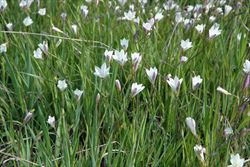
infestation (Photo: Rob and Fiona Richardson)

habit (Photo: Rob and Fiona Richardson)

elongated, strap-like leaves (Photo: Rob and Fiona Richardson)
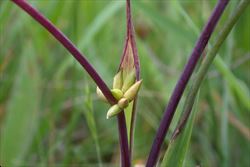
stems, with a cluster of bulbils in a leaf fork (Photo: Rob and Fiona Richardson)

whitish tubular flowers (Photo: Rob and Fiona Richardson)
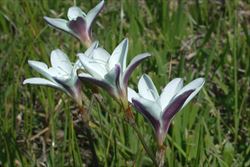
flowers from side-on showing purple-tinged undersides (Photo: Rob and Fiona Richardson)
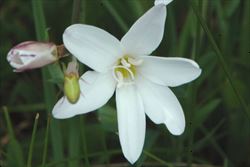
close-up of flower with white anthers (Photo: Rob and Fiona Richardson)
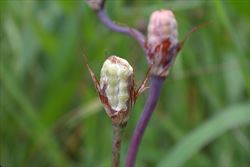
immature fruit (Photo: Rob and Fiona Richardson)
Scientific Name
Sparaxis bulbifera (L.) Ker Gawl.
Synonyms
Ixia bulbifera L.Sparaxis grandiflora Ker Gawl. (misapplied)
Family
Iridaceae
Common Names
bulbil sparaxis, harlequin flower, harlequin-flower, sparaxis, white harlequin flower
Origin
Native to south-western Africa (i.e. Cape Province in South Africa).
Cultivation
Harlequin flower (Sparaxis bulbifera) has been cultivated as a garden ornamental in the temperate regions of Australia.
Naturalised Distribution
Widely naturalised in southern Australia (i.e. in the coastal and sub-coastal districts of central New South Wales, in central and southern Victoria, in Tasmania, in many parts of south-eastern and southern South Australia, and in south-western Western Australia.
Also naturalised overseas in the Azores.
Habitat
A weed of heathlands, heathy woodlands, grasslands, grass woodlands, open woodlands, seasonal wetlands, roadsides, drainage lines, disturbed sites and waste areas in the temperate regions of Australia.
Habit
An upright (i.e. erect) herbaceous plant growing 15-60 cm tall. Its short-lived (i.e. annual) stems and leaves re-grow each year from a long-lived (i.e. perennial) underground 'bulb' (i.e. corm). These corms are usually 10-15 mm across.
Distinguishing Features
- an upright herbaceous plant growing 15-60 cm tall.
- its short-lived stems and leaves re-grow each year from a long-lived underground 'bulbs'.
- its elongated leaves (10-30 cm long and 4-13 mm wide) are mostly clustered at the base of the plant.
- numerous small bulb-like structures are produced in the upper leaf forks.
- its tubular flowers are predominantly white or cream, but often tinged with pale yellow or purple.
Stems and Leaves
The few-branched flowering stems (i.e. scapes) are green and hairless (i.e. glabrous).
The elongated (i.e. linear) or sword-shaped (i.e. ensiform) leaves are clustered as the base of the plant or alternately arranged along the stems. These leaves (10-30 cm long and 4-13 mm wide) are sheathed at the base with entire margins and pointed tips (i.e. acute apices). They are hairless (i.e. glabrous), pale green in colour, and have a prominent mid-vein. Numerous small bulb-like structures (i.e. bulbils) are produced in their forks (i.e. axils).
Flowers and Fruit
The flowers are arranged in spikes (of 1-6 flowers) at the tips of the flowering branches. Each flower is subtended by two leafy flower bracts (1.5-2.5 cm long). These stalkless (i.e. sessile) flowers are predominantly white or cream, but may occasionally be pale yellow or purple-tinged (especially on their undersides). Each flower has six 'petals' (i.e. tepals or perianth segments) that are 3-4.5 cm long and joined together at the base into a short tube (i.e. corolla tube) about 15 mm long. They also have three stamens, with whitish anthers 7-8 mm long, and an ovary topped with a style ending in three short branches (about 10 mm long). Flowering occurs mainly during spring and early summer (i.e. from September to December).
The fruit is a capsule (up to 10 mm long by 7 mm wide) that turns light green to brown as it matures. These capsules contain several rounded (i.e. globose) seeds (about 2 mm across) that are black or reddish-black in colour.
Reproduction and Dispersal
The seeds and bulbils can be spread by slashing, mowing or water movement. Seeds, bulbils and 'bulbs' (i.e. corms) can also be dispersed in dumped garden refuse and soil-moving activities (e.g. earth-moving, road-making and grading).
Environmental Impact
Harlequin flower (Sparaxis bulbifera) is regarded as a significant environmental weed in Victoria, South Australia and Western Australia.
Legislation
Not declared or considered noxious by any state government authorities.
Similar Species
Harlequin flower (Sparaxis bulbifera) may be confused with tricolor harlequin flower (Sparaxis pillansii) and tritonia (Tritonia crocata). These species can be distinguished by the following differences:
- harlequin flower (Sparaxis bulbifera) has white flowers with three white anthers. Its floral bracts are divided in two just below their tips.
- tricolor harlequin flower (Sparaxis pillansii) has colourful flowers (often red, orange or pink with yellow centres) with three yellow to brown anthers. Its floral bracts are divided in two just below their tips.
- tritonia (Tritonia crocata) has white flowers with three white anthers. Its floral bracts have entire tips.

